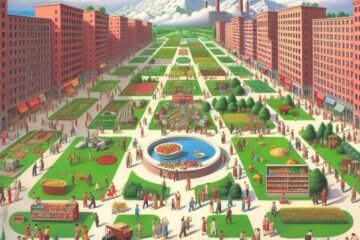Bangalore, the IT capital of India, is also emerging as a leader in green living. The city is witnessing a surge of sustainable practices and eco-friendly initiatives, both at the individual and collective level. From eco-friendly homes to green transportation, from waste management to green buildings, Bangalore is setting an example for other cities to follow. In this article, we will explore some of the remarkable efforts and achievements of Bangalore in promoting green living.

Eco-Friendly Homes: A Trend that is Catching On
One of the most visible signs of green living in Bangalore is the increasing number of eco-friendly homes. These are homes that are designed and constructed to minimize the environmental impact and maximize energy efficiency. Some of the features of eco-friendly homes are:
- Use of natural and organic materials, such as mud, clay, bamboo, and jute, instead of bricks, cement, and steel.
- Use of renewable energy sources, such as solar panels, wind turbines, and biogas plants, to power the appliances and lighting.
- Use of rainwater harvesting systems, water-saving fixtures, and greywater recycling systems to conserve and reuse water.
- Use of natural ventilation, skylights, and green roofs to reduce the need for artificial cooling and heating.
- Use of organic gardening, composting, and waste segregation to reduce waste generation and enhance soil quality.
Some examples of eco-friendly homes in Bangalore are Hombelaku, a house made of handmade mud blocks with skylights, solar heaters, and an organic vegetable garden; and Godrej Properties’ projects, such as Godrej Woodsman Estate and Godrej Platinum, which are certified by the Indian Green Building Council (IGBC) and offer energy-efficient appliances, rainwater harvesting, and solar lighting.
Green Transportation: A Shift Towards Cleaner and Greener Mobility
Another aspect of green living in Bangalore is the adoption of green transportation options, which aim to reduce the carbon footprint and air pollution caused by conventional vehicles. Some of the green transportation options available in Bangalore are:
- Public transportation, such as buses, metros, and trains, offers a convenient, affordable, and eco-friendly way of commuting. Bangalore has one of the largest bus networks in India, with over 6,000 buses operated by the Bangalore Metropolitan Transport Corporation (BMTC). The city also has a metro rail system, known as Namma Metro, which covers a distance of 55 km and connects 40 stations. The city is also planning to introduce suburban rail services, which will connect the outskirts of the city with the central areas.
- Non-motorized transportation, such as walking, cycling, and e-scooters, offers a healthy, fun, and zero-emission way of traveling. Bangalore has several pedestrian-friendly zones, such as MG Road, Brigade Road, and Church Street, where vehicles are restricted or banned. The city also has dedicated cycle lanes, such as the one along the Outer Ring Road, which spans 42 km and connects 12 major IT hubs. The city also has several bike-sharing and e-scooter rental services, such as Yulu, Bounce, and Vogo, which allow users to rent bikes and scooters for short distances.
- Electric vehicles, such as electric cars, bikes, and buses, offer a low-carbon and low-noise alternative to fossil fuel-based vehicles. Bangalore has several initiatives and incentives to promote electric vehicles, such as the Karnataka Electric Vehicle and Energy Storage Policy, which offers subsidies, tax exemptions, and charging infrastructure for electric vehicles. The city also has several electric vehicle manufacturers and startups, such as Mahindra Electric, Ather Energy, and Sun Mobility, which offer innovative and affordable electric vehicles and solutions.
Waste Management: A Challenge that is Being Tackled Head-On?
One of the biggest challenges of green living in Bangalore is the management of the huge amount of waste generated by the city. The city produces over 5,000 tonnes of waste per day, which is mostly dumped in landfills, causing environmental and health hazards. However, the city is also taking several steps to tackle this challenge, such as:
- Segregation of waste at source, which involves separating the waste into different categories, such as wet, dry, and hazardous, at the household or community level, This helps reduce the amount of waste sent to landfills and facilitates the recycling and reuse of waste. The city has implemented the Solid Waste Management Rules, 2016, which mandate the segregation of waste at source and impose penalties for non-compliance. The city also has several citizen groups and NGOs, such as Hasiru Dala, Saahas, and Daily Dump, which educate and assist the residents in segregating and managing their waste.
- Composting of organic waste, which involves converting wet waste, such as kitchen and garden waste, into compost, which can be used as a natural fertilizer for plants. This helps reduce the amount of waste sent to landfills and enhances the soil quality and crop yield. The city has several initiatives and incentives to promote composting, such as the Swachhagraha scheme, which offers a 50% rebate on property tax for households that compost their waste. The city also has several composting solutions and products, such as the Kasa Rasa centers, which are decentralized waste processing units that convert wet waste into compost and biogas; and the Smartbin, which is a home composting kit that converts wet waste into compost and liquid fertilizer.
- Recycling of dry waste, which involves collecting, sorting, and processing dry waste, such as paper, plastic, metal, and glass, into new products or materials. This helps reduce the amount of waste sent to landfills and conserves natural resources and energy. The city has several initiatives and incentives to promote recycling, such as the Dry Waste Collection Centres (DWCCs), which are designated places where the dry waste is collected, segregated, and sold to recyclers; and the Kachra Mane, which is a waste exchange platform that connects waste generators, collectors, and recyclers.
Green Building: A New Paradigm for Sustainable Construction
The final aspect of green living in Bangalore is the emergence of green building, which is a new paradigm for sustainable construction. Green building is the practice of designing, constructing, and operating buildings in a way that minimizes the environmental impact and maximizes human health and comfort. Some of the features of green buildings are:
- Use of eco-friendly materials, such as bamboo, recycled wood, fly ash bricks, and natural paints, which reduce the embodied energy and the carbon footprint of the building.
- Use of energy-efficient designs, such as passive solar design, natural ventilation, daylighting, and green roofs, which reduce the operational energy and the cooling and heating load of the building.
- Use of renewable energy sources, such as solar, wind, and biogas, which reduce the dependence on fossil fuels and the greenhouse gas emissions of the building.
- Use of water conservation systems, such as rainwater harvesting, greywater recycling, and low-flow fixtures, which reduce the water consumption and the wastewater generation of the building.
- Use of waste management systems, such as composting, recycling, and biodegradation, which reduce waste production and the landfill impact of the building.
Some examples of green buildings in Bangalore are the CII-Sohrabji Godrej Green Business Centre, which is a platinum-rated green building by the IGBC and the LEED and offers consultancy, training, and certification services for green buildings; and the Manyata Tech Park, which is a gold-rated green building by the IGBC and houses several IT and ITES companies.






